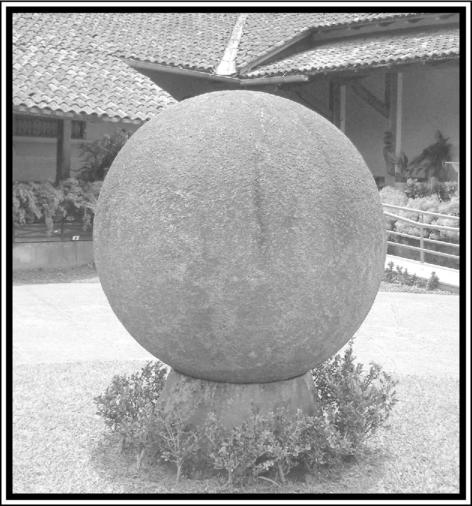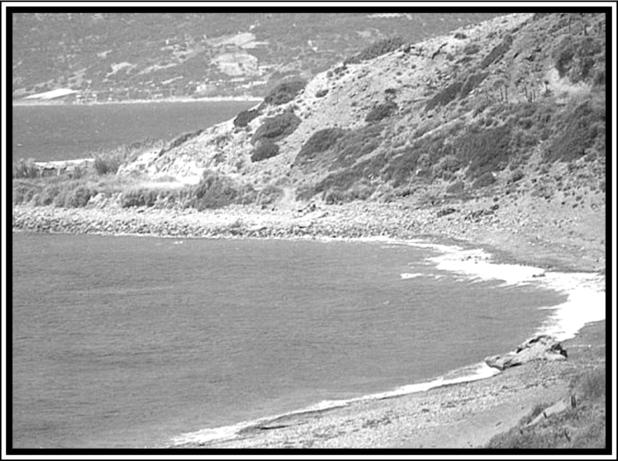Hidden History: Lost Civilizations, Secret Knowledge, and Ancient Mysteries (26 page)
Read Hidden History: Lost Civilizations, Secret Knowledge, and Ancient Mysteries Online
Authors: Brian Haughton
Tags: #Fringe Science, #Gnostic Dementia, #U.S.A., #Alternative History, #Amazon.com, #Retail, #Archaeology, #History


Photograph by Connor Lee. (GNU Free Documentation License).
Stone sphere in the courtyard of El Musco Nacional.
One of the most enigmatic puzzles
of pre-Columbian America is that of
the mysterious stone spheres of Costa
Rica. Hundreds of these stone balls,
varying in size from a few centimeters
to 7 feet in diameter and the largest
weighing 16 tons, have been found in
the Diquis region near the towns of
Palmar Sur and Palmar Norte, close
to the Pacific coast of southern Costa
Rica. The majority are fashioned from
granodiorite, a hard, igneous rock
similar to granite, but there are a few
examples made of coquina, a type of
limestone composed mostly of shells
and shell fragments.
The spheres first came to light in
the 1930s, when the United Fruit Company was clearing jungle to plant banana and other fruit trees. Workers for
the company discovered the objects
and, remembering a local legend about
the spheres being built around a core
of gold, blew many of them apart with dynamite looking for the hidden gold.
In 1948, Dr. Samuel Lothrop of the
Peabody Museum at Harvard University, and his wife, studied the stone
balls in context, and in 1963 the final
report of the study was published. In
his report, Lothrop records a total of
186 examples, although he had also
heard of a site near Jalaca that had
another 45 balls, before they were
taken away to other locations. There
have also been finds on Cano Island,
12.5 miles west of the southern Pacific
coast. On this evidence it seems that
there were once several hundred of
these stone sculptures in existence.
Since the 1940s, most of the balls have
been removed from their original context, often being transported by rail all
over the country. Today, only six are
known to remain in their original positions. Some can be seen displayed in
the National Museum, and several are
in parks and gardens in the country's
capital, San Jose.
Scholarly research into the Costa
Rica stone spheres has been going on
for more than 60 years. It began in 1943
with a study of the objects by archaeologist Doris Zemurray Stone, daughter of Samuel Zemurray, founder of the
United Fruit Company. She examined
the stones directly after they were discovered by workers for the Fruit Company. Stone, later to become the
director of the National Museum of
Costa Rica, published her findings in
the journal American Antiquity in 1943.
The study contains plans of five sites,
including 44 stone balls, and her interpretation was that the spheres
could have served as cult images or
cemetery markers, or were perhaps
connected with some kind of calendar.
The publication of the Lothrops' study
in 1963 includes maps of sites where
the spheres were found, and comprehensive accounts of pottery and metal
artifacts found in association with
and in the vicinity of them. Also included are numerous photographs and
drawings of the spheres, including
measurements and notes on their
alignments.
Further archaeological excavations in the 1950s found the stone
spheres associated with pottery and
other artifacts known from the preColumbian cultures of southern Costa
Rica. There have been various other
studies made since then, the most thorough being that of archaeologist
Ifigenia Quintanilla of the National
Museum of Costa Rica, from 1990 to
1995. Archaeologists have long puzzled
over the origin of these strange
spheres, and whether they were natural or man-made is still a much discussed point. Some geologists have
suggested that the stones were formed
naturally, theorizing that after a volcano released magma into the air, it
settled in a hot, ash-filled valley; the
blobs of magma then gradually cooled
down to form spheres. Another suggestion is that the original granite
blocks were positioned in a man-made
pit at the bottom of a powerful waterfall, and the effect of the water continuously flowing over them slowly
modeled the stones into near-perfect
spheres. Despite these theories, it is
more probable that the stones are manmade, especially in view of the fact
that the granodiorite from which the
majority of them were created does
not occur naturally in the area. The
quarry from which the rock originated is located in the Talamanca mountain
range, about 50 miles from the area
where the balls have been found. Archaeologist Ifigenia Quintanilla carried out fieldwork in the area of the
finds from 1990 to 1995 and traced the
source of the raw material, as well as
some boulders that were possibly unfinished examples of the stone
spheres. Quintanilla's excavations also
revealed flakes from the balls that indicate how they were made. Her findings suggest that the most plausible
method would have been to begin by
reducing a roughly circular boulder to
a more spherical shape by alternative
heating and cooling to fracture the
rock. The builders could then have
smoothed them out using hard stone
hammers, possibly of the same material, and finally polished them using
other stone tools.
One misconception about the objects is that they are almost perfect
spheres, accurate to within "0.5 inch
or 0.2 percent" as some have suggested.
This is not the case, as there have been
no such precise measurements of the
spheres. The balls are not flawlessly
smooth at all, some can differ more than
5 centimeters in diameter from a true
sphere. A problem of a different type
is how pre-Columbian societies moved
the stones to their required locations.
Such a task certainly points to an advanced and organized culture (though
if the stones were carved in a mountain quarry, it is obvious that spherical objects roll fairly easily, especially
downhill).
The question of who made these
mysterious spheres and why is a more
complicated issue. According to archaeologists the spheres were shaped
during two separate cultural periods.
Only a handful of spheres remain from
the earlier of these, known as the
Aguas Buenas period, which lasted
from around A.D. 100 to 500. In the second phase, the Chiriqui period (which
dates from around A.D. 800 to 1500), a
larger amount of the stone spheres
appear to have been manufactured,
with a distribution along the lower
part of the Terraba River. However,
this does not tell us anything about the
function of the spheres. Leaving aside
helpful intervention by extraterrestrials or Atlanteans, the most unique
theory is that they were set up by an
extremely advanced prehistoric culture to function as antennae-forming
part of an ancient worldwide power
grid. However, without concrete evidence, such a theory is baseless, and
just as mythical as the local legend that
the local people had access to a potion
with which they were able to soften
the rock. In their 1998 book, Atlantis
in America: Navigators of the Ancient
World, Ivar Zapp and George Erikson
suggest that the spheres were set up
as navigational instruments by an advanced ancient seafaring race, a race
that influenced the Greek philosopher
Plato to write about the lost land of
Atlantis. However, this theory requires
the spheres to be placed close enough
to the coast to be seen by navigators,
which is not the case. It also presupposes an accuracy in the alignments
of the spheres not present in the examples we have left in their original
context.
We don't really know why these
objects were made, especially as most
of them have been moved from their
original locations. This is a significant
problem, as the placements of the stone balls was probably of vital importance
to the people who first positioned
them. However, going on the available
evidence, the most probable theory for
a number of the spheres is that they
were used as markers of some kind,
perhaps property boundaries or status
symbols. Another idea, taking into account that many of the balls were originally found in alignments, is that they
represent the sun, moon, and all the
known planets at the time of their
placement. It has even been suggested
that they represent the entire solar
system. An interesting fact noted by
Lothrop in the 1940s was that several
of the balls he examined seemed to
have tumbled down from neighboring
mounds, which were formerly the sites
of houses. Perhaps the spheres had
once been contained inside these
structures on top of the mounds,
though this would make them ineffective for astronomy, and certainly of no
use to navigators. It is likely that the
spheres had numerous purposes,
which perhaps changed over the 1,000
years they were around. One interesting idea is that the laborious manufacture of the spheres may itself have
been a significant ritual as importantor perhaps more important-than the
finished product.
Ever since their discovery, the
stone spheres of Costa Rica have been
affected by exposure to temperature
changes, damage from rain and irrigation, and periodic burning. In 1997, the
Landmarks Foundation was created to
conserve sacred sites and landscapes
around the world. In 2001, with the
cooperation of various governmental
organizations, the Foundation and the
National Museum of Costa Rica were
able to transport many of the spheres
from San Jose across the high mountain range and back to their original
homes. They are currently being
stored and protected until a Cultural
Center can be constructed to house and
display them in their original locations
in the Diquis Delta.
Archaeologists still occasionally
find new examples of the spheres in
the mud of the Diquis Delta, and there
are probably more out there. In modern day Costa Rica, the stones can be
found in museums and adorning the
lawns outside various official buildings, hospitals, and schools. Two of
them have been transported to the
United States: one is on display in the
museum of the National Geographic
Society in Washington, D.C., while the
other is in a courtyard near the
Peabody Museum of Archaeology and
Ethnography at Harvard University in
Cambridge, Massachusetts. The
spheres can also be found decorating
the gardens of the homes of the rich,
where they are regarded as status symbols. In a way then, though many of the
stones have long ago been moved from
their place of origin, some of them at
least may be serving the purpose for
which they were originally intended.


Photograph by Y. Dondas
The coast of Crete, which was once patrolled by the bronze giant, Talos.
Many people are familiar with the
figure of Talos through his depiction
as a bronze giant in the 1963 movie
Jason and the Argonauts using Ray
Harryhausen's stunning special effects. But where did the idea for Talos
come from, and could he have been the
first robot in history?
Originally, Talos was a figure of
Cretan legend, though there are many
diverse myths to account for his origins. After Zeus kidnapped Europa
and took her to Crete, he gave her
